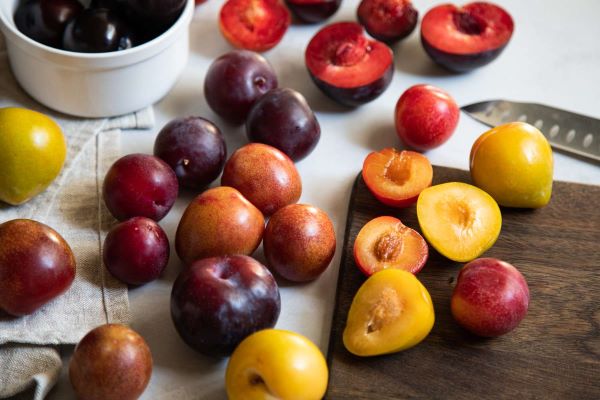Plums are juicy, sweet, and tangy fruits that come in a variety of colors, shapes, and flavors. They are widely cultivated around the world and are appreciated for their nutritional benefits and culinary versatility. Here, we explore some of the most notable plum varieties, including their origins, history, where they are found, availability, and unique properties.
Contents
1. Black Plum (Jamun)
- Origin: India, Southeast Asia
- History: Cultivated for centuries in India and surrounding regions, used in traditional medicine and cuisine.
- Found in: India, Bangladesh, Sri Lanka, and Southeast Asia
- Availability: June to August
- Unique Property: Known for its deep purple to black skin, tart flavor, and juicy flesh. It is rich in antioxidants and used in traditional medicine for managing diabetes and digestive issues.
2. Santa Rosa
- Origin: USA
- History: Developed by Luther Burbank in Santa Rosa, California, in the early 20th century.
- Found in: USA, Japan, and some parts of Europe
- Availability: June to August
- Unique Property: Known for its reddish-purple skin and sweet, tart flavor. It has a firm texture and is excellent for fresh eating and cooking.
3. Damson
- Origin: Syria
- History: Brought to Europe and cultivated widely for its unique flavor and culinary uses.
- Found in: Europe, USA, and parts of Asia
- Availability: August to October
- Unique Property: Known for its small size, dark blue skin, and tart flavor. Often used for making jams, jellies, and preserves due to its high pectin content.
4. Yellow Plum (Mirabelle)
- Origin: France
- History: Cultivated in the Lorraine region of France for centuries and is protected by a geographical indication.
- Found in: France, Germany, and Luxembourg
- Availability: July to September
- Unique Property: Known for its small size, yellow skin, and sweet flavor. Often used in desserts, jams, and brandy production.
5. Greengage
- Origin: Armenia, introduced to Europe
- History: Brought to Europe by Sir William Gage in the 18th century.
- Found in: Europe, particularly France and the UK
- Availability: August to October
- Unique Property: Known for its green skin and sweet, honey-like flavor. It has a firm texture and is excellent for fresh eating and cooking.
Also, read: Different Types of Apples in India You Need to Know Now
6. Victoria
- Origin: UK
- History: Discovered in Sussex, England, in the 19th century and named after Queen Victoria.
- Found in: UK, Europe, and Australia
- Availability: August to September
- Unique Property: Known for its yellow flesh and red mottled skin. It has a sweet flavor and is versatile for eating fresh, cooking, and making jams.
7. Elephant Heart
- Origin: USA
- History: Developed by Luther Burbank in the early 20th century, known for its large size and unique appearance.
- Found in: USA and parts of Europe
- Availability: August to September
- Unique Property: Known for its heart-shaped, dark red skin and flesh. It has a rich, sweet flavor and is excellent for fresh eating and desserts.
8. Satsuma
- Origin: Japan
- History: Brought to the USA from Japan in the late 19th century.
- Found in: Japan, USA, and parts of Europe
- Availability: July to September
- Unique Property: Known for its dark red to purple skin and sweet, juicy flesh. Often used for fresh eating and making plum wine.
9. Methley
- Origin: South Africa
- History: Brought to the USA and other parts of the world for its adaptability and sweet flavor.
- Found in: South Africa, USA, and Australia
- Availability: June to August
- Unique Property: Known for its red skin and sweet, juicy red flesh. It is an early-season plum, excellent for fresh eating and jams.
Also, watch web stories: What are the benefits of a keto diet?
10. Cherry Plum (Myrobalan)
- Origin: Western Asia, Europe
- History: One of the earliest cultivated plums, used for centuries in traditional medicine and cuisine.
- Found in: Europe, Western Asia, and North America
- Availability: July to September
- Unique Property: Known for its small size, red to yellow skin, and sweet-tart flavor. It is often used for making preserves and in traditional dishes.
Nutrition Chart of Plums
Plums are not just delicious but also packed with essential nutrients. Here’s a general nutritional profile of plums per 100 grams:
| Nutrient | Amount |
|---|---|
| Calories | 46 kcal |
| Carbohydrates | 11.4 g |
| Sugars | 9.9 g |
| Dietary Fiber | 1.4 g |
| Protein | 0.7 g |
| Fat | 0.3 g |
| Vitamin A | 17 µg |
| Vitamin C | 9.5 mg |
| Vitamin E | 0.3 mg |
| Vitamin K | 6.4 µg |
| Potassium | 157 mg |
| Magnesium | 7 mg |
| Phosphorus | 16 mg |
| Folate | 5 µg |
| Calcium | 6 mg |
| Iron | 0.2 mg |
| Zinc | 0.1 mg |
| Thiamine (B1) | 0.03 mg |
| Riboflavin (B2) | 0.03 mg |
| Niacin (B3) | 0.4 mg |
| Vitamin B6 | 0.03 mg |





